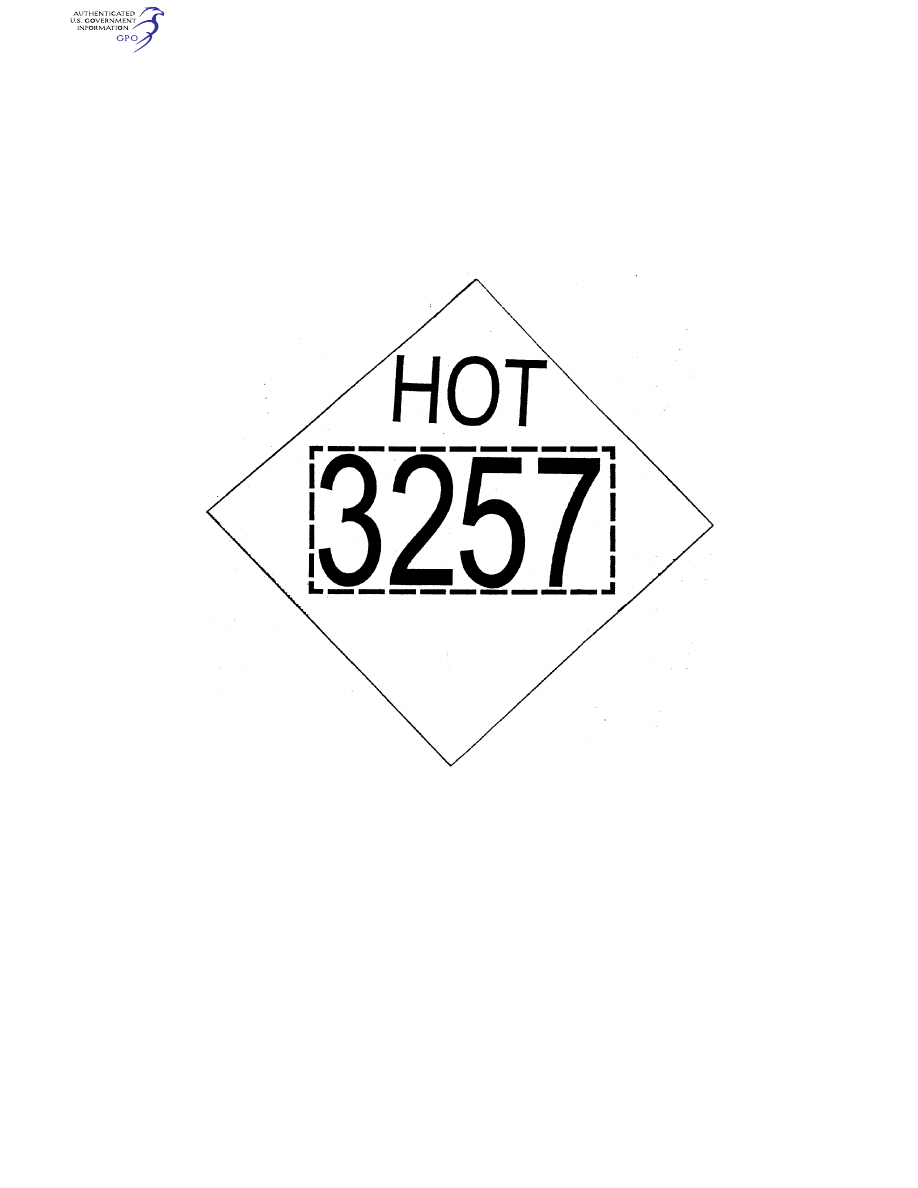
409
Pipeline and Haz. Matls. Safety Admin., DOT
§ 172.326
[Amdt. 172–125, 58 FR 3348, Jan. 8, 1993, as amended by Amdt. 172–139, 59 FR 67487, Dec. 29, 1994]
§ 172.326
Portable tanks.
(a)
Shipping name.
No person may
offer for transportation or transport a
portable tank containing a hazardous
material unless it is legibly marked on
two opposing sides with the proper
shipping name specified for the mate-
rial in the § 172.101 table. For transpor-
tation by vessel, the minimum height
for a proper shipping name marked on
a portable tank is 65 mm (2.5 inches);
except that portable tanks with a ca-
pacity of less than 3,000 L (792.52 gal-
lons) may reduce the marking size to
not less than 12 mm (0.47 inches).
(b)
Owner’s name.
The name of the
owner or of the lessee, if applicable,
must be displayed on a portable tank
that contains a hazardous material.
(c)
Identification numbers.
(1) If the
identification number markings re-
quired by § 172.302(a) are not visible, a
transport vehicle or freight container
used to transport a portable tank con-
taining a hazardous material must be
marked on each side and each end as
required by § 172.332 with the identifica-
tion number specified for the material
in the § 172.101 table.
(2) Each person who offers a portable
tank containing a hazardous material
to a motor carrier, for transportation
in a transport vehicle or freight con-
tainer, shall provide the motor carrier

410
49 CFR Ch. I (10–1–23 Edition)
§ 172.327
with the required identification num-
bers on placards, orange panels, or the
white square-on-point configuration, as
appropriate, for each side and each end
of the transport vehicle or freight con-
tainer from which identification num-
bers on the portable tank are not visi-
ble.
(d)
NON-ODORIZED marking on port-
able tanks containing LPG.
No person
may offer for transportation or trans-
port a portable tank containing
unodorized liquefied petroleum gas
(LPG) as authorized in § 173.315(b)(1) of
this subchapter unless it is legibly
marked NON-ODORIZED or NOT
ODORIZED on two opposing sides near
the marked proper shipping name re-
quired by paragraph (a) of this section,
or near the placards. The NON-ODOR-
IZED or NOT ODORIZED marking may
appear on a portable tank used for both
unodorized and odorized LPG.
[Amdt. 172–123, 55 FR 52592, Dec. 21, 1990, as
amended at 56 FR 66255, Dec. 20, 1991; 69 FR
64471, Nov. 4, 2004; 76 FR 3367, Jan. 19, 2011; 80
FR 1150, Jan. 8, 2015; 81 FR 35540, June 2, 2016]
§ 172.327
Petroleum sour crude oil in
bulk packaging.
A Bulk packaging used to transport
petroleum crude oil containing hydro-
gen sulfide (
i.e.,
sour crude oil) in suffi-
cient concentration that vapors
evolved from the crude oil may present
an inhalation hazard must include a
marking, label, tag, or sign to warn of
the toxic hazard as follows:
(a) The marking must be durable,
legible and of a size relative to the
package as to be readily visible and
similar to the illustration shown in
this paragraph with the minimum di-
mension of each side of the marking at
least 100 mm (3.9 inches) as measured
from the outside of the lines forming
the border. The width of the border
forming the square-on-point marking
must be at least 5 mm. The marking
must be displayed at each location
(
e.g.
, manhole, loading head) where ex-
posure to hydrogen sulfide vapors may
occur.
(1)
Transitional exception
—A marking
in conformance with the requirements
of this paragraph in effect on December
31, 2014, may continue to be used until
December 31, 2016.
(2) For domestic transportation, a
packaging marked prior to January 1,
2017 and in conformance with the re-
quirements of this paragraph in effect
on December 31, 2014, may continue in
service until the end of its useful life.
(b) The border of the square-on-point
must be black or red on a white or
other suitable contrasting background.
The symbol must be black and located
in the center of the square-on-point
and be clearly visible as follows:

